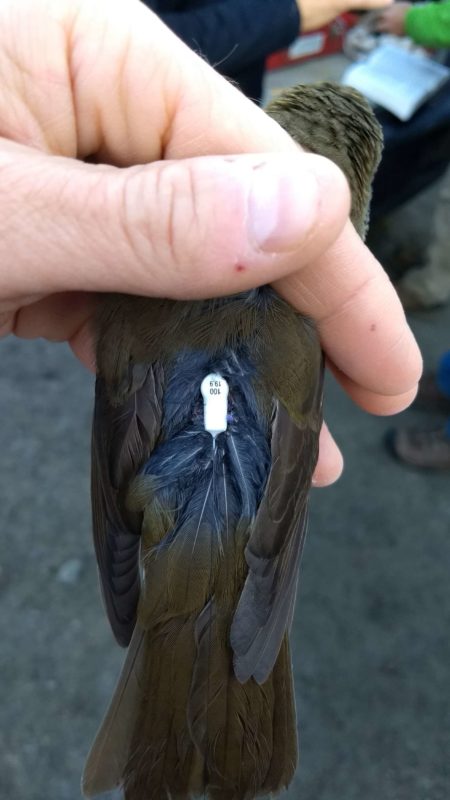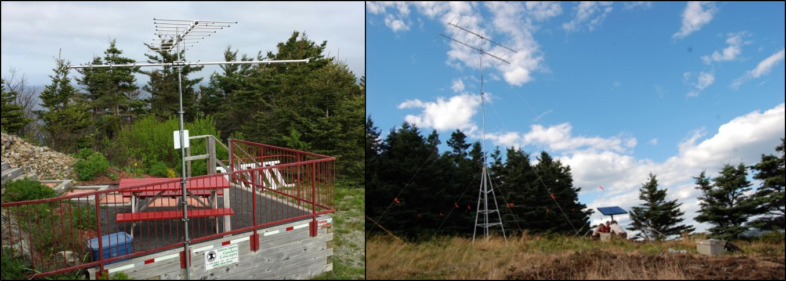If you own property in New England, you have an incredible opportunity this winter to benefit wildlife populations and make a real contribution to conservation science by hosting a Motus tower. The Motus Wildlife Tracking System is a collaborative research effort, organized by Birds Canada, that uses radio telemetry arrays scattered across the landscape to track the movements of bats, dragonflies, and birds that are carrying miniature Motus tags. Here at VCE, we have successfully deployed Motus tags to track the migration of Swainson’s and Bicknell’s Thrush, and I am involved in the effort to expand the New England Motus network.

Jason Hill prepares to release a Bicknell’s Thrush affixed with a Motus tracking tag in September of 2017, atop Mt. Mansfield. © Jason Hill
In New England, most of the existing towers are located along the Long Island Sound, which is great for those species that migrate along the coast or make transoceanic flights (like Blackpoll Warblers). But what about species that migrate inland, down the spine of the Appalachian Mountains, like hoary bats? Well, thanks to a large State Wildlife Grant from the U.S. Fish & Wildlife Service, there is now funding and a vigorous effort to add ~50 towers to private and public properties in interior New England in early 2021.
For each proposed hosting site, an engineer from the New England Motus Network will contact the landowner and conduct a site visit for promising locations. The engineer will tailor the tower design to your specific property, but all towers need a clear view of the horizon. The grant covers all of the cost of the equipment, installation (~1 day), and engineer’s time. Depending on the conditions at a potential site, these towers might be a 7’ tall assembly attached to the top of a fire tower, silo, former TV antenna tower, or unused utility pole. If you have an open field, then a free-standing 25’ tower would be more appropriate. Each tower is equipped with a small receiver that stores detections of tagged animals that pass near the towers (larger towers can detect outwards of 15 km in all directions). One of these receivers uses as much energy as a lightbulb, and it can be powered with a small solar panel (also covered by the grant) or from a household electrical outlet.
Interested? Of course you are! First, check out this brief Introduction to Motus for Landowners for more specifics on what it means to host a tower, and view this interactive map with green lines indicating where towers are approximately desired in interior New Hampshire and Vermont. Second, check out this video to see examples of Motus towers, and finally, use this Google form to suggest a possible Motus tower location. Someone from the New England Motus network will contact you to determine if your proposed site(s) are appropriate for a tower. Feel free to reach out to me with any questions as well.

Examples of Motus tower arrays on Grand Manan Island, New Brunswick (left) and in a field (right). Photos courtesy of Birds Canada.

Interested! Jenn
Right on Jenn!
david Hi. We have conservation land located in Alstead, NH. We would be very interested in hosting a Motus Tower.
Good luck in enlarging the network.
David
That’s awesome! Please do fill out that Google form linked to in the article. Please let me know what the engineer thinks of your location.
Hello! We would be happy to host one of these on our property. I live adjacent to the marsh on Bristol Pond in Bristol, VT. We have a large variety of birds that visit our property. I submit my findings to EBird. We have 5 acres of land which includes open land, trees and marsh land.
Awesome. I know that they’re really need more potential properties to choose from. If you fill out that Google form, Kristine, then they’ll get back to you shortly.
Meed a Motus on groveback min.
Hi Scott, is that “Groveback Mountain”? Where is that located? Thanks.
What is the potential for a Motus tower in Massachusetts? The grant is for VT and NH. We have a high elevation water tower on the Bridgwater State University Campus. Also have a friend with a potential location in the Berkshires just 1 km south of the VT border in Monroe, MA on 85 acres
Hi Kevin,
I would definitely propose your locations in that Google form, so that there’s a record for them. There very well may be other pools of money (I’m not aware of them all) for Massachusetts and other places right now or in the future. The water tower would be such an outstanding location (due to its elevation above the landscape) that I’m sure they’d be really interested. Thank you so much.
Does “clear view of the horizon” mean you need to be at the top of a hill?
Hi Ingrid,
Not necessarily. It just means that you need to be able to see for a decent distance. In the middle of a field is also a great location, whereas in a hollow would not be. If you do out the Google form then the engineers will be able to help you determine how suitable your location is for a tower. Thank you!!
Interesting …. We have property in Ferrisburgh VT on South Slang. I will check out your info
Wonderful, thank you Betsy. It’s a pretty cool way to contribute directly to wildlife research.
Is there a way to tell if a tower is “needed” in a particular area? And are there restrictions such as “not within 50 miles of an existing tower” or “not in a State Park”?
Hi Kelly,
Good questions. The towers (placed in an appropriate location) typically provide coverage outward for <8 miles in all directions (depending on the size and number of antenna arrays). So a tower 10 miles from another tower wouldn't be 'too far' at all. The interactive map is a good place to start to ID areas of our states with a need for more towers. I'm looking at it now, and I see very few existing or proposed towers in the south-central and southwestern Vermont and southern New Hampshire. So more towers down there are definitely needed. I'm also seeing lots of gaps along the northern green line on the map. Keep in mind, that a lot of proposed locations may turn out to not be a good fit once the engineers look more closely at the topography and such. So there's no harm in proposing another location that's very near another proposed one--your location might be much better.
State parks are great locations, but of course, the park personnel would have to be fully behind it. There are lots of existing towers across the US and Canada on state and federal property--sometimes right at the visitor center if it's in a 'good' location.
Right now, we do not have good knowledge of where (precisely) migrant wildlife fly along Vermont and New Hampshire in the spring in fall, so we're not in a knowledgeable position to say (for example), 'we need lots of towers in the Champlain Valley.' All of these Motus towers going up will definitely help researchers like myself, identify the major flight pathways in our two states. After a few more years of data collection with all the new towers, we'll be in a much better position to determine where we need to put towers in a much denser configuration (b/c of the abundance of migrants passing through that area).
We have property at the south end of lake Willoughby. We wake up every morning and have a spectacular view of the South end of Willoughby. Last week we saw a Bald Eagle on two Mornings. Loons, Artic Loons, ducks are common. I think we would be a fantastic site.
Right on, Steve! That property must be amazing. Definitely, please fill out the Google form linked in the blog post above, and I suspect that Todd Alleger will reach out to you. You can read more about Todd and the Northeast Motus Collaboration here (https://www.northeastmotus.com/about-us). Thank you!!